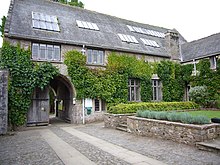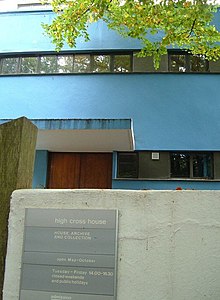Dartington Hall
| Dartington Hall | |
|---|---|
|
Medieval hall |
|
| Creation time : | 1388-1399 |
| Geographical location | 50 ° 27 '6.5 " N , 3 ° 41' 37.7" W |
Dartington Hall is a mansion near Totnes in Devon , UK . Classified as a Grade I Cultural Monument, the mansion became known as the site of the Dartington Hall School .
history
The area of Dartington Hall was probably settled as early as Roman times, Dartington is mentioned for the first time in 833 in a royal charter. Around 1100 it belonged to the Norman nobleman Robert Fitz Martin , after his death it remained in the possession of his descendants. By marriage it fell in 1343 to James Audley, 3rd Baron Audley of Heleigh , who, however, had to return it to the crown in 1348. Richard II gave the estate to his half-brother John Holland . After he was named Earl of Huntingdon and finally Duke of Exeter , he expanded Dartington Hall into his residence. It remained in the possession of the Dutch heirs until 1475. After the death of Henry Holland in 1475, it fell to the second husband of his widow Anne of York , Thomas St. Leger . After his unsuccessful rebellion against Richard III. In 1483 Dartington Hall returned to the crown. In 1487 the estate was given to Margaret Beaufort for life ; Henry VIII gave the estate to two of his wives, Katharina Howard and Katharina Parr .
Arthur Champernowne acquired the property in 1559 . After Rawlin Champernowne's death in 1774, the Harrington family inherited Dartington Hall. The family became impoverished in the 19th century, so that they had to sell large parts of their land holdings at the beginning of the 20th century. In 1925 the couple Dorothy and Leonard Elmhirst bought Dartington Hall with the remaining 320 hectares of land. At that time, the medieval hall was roofless and dilapidated, the other buildings were used for agriculture and were badly run down. The Elmhirsts bought the country estate as the location for their school, Dartington Hall School, and invested a lot of time and money over the years to renovate and expand the buildings. In addition to the restoration of the medieval buildings, architecture critics from all over Europe and North America became aware of Dartington Hall when the American-Swiss architect William Lescaze built the High Cross House , several residential buildings, three sleeping houses for the students and the administration in the modern style , as well as Walter Gropius helped convert an old barn into a theater.
In 1961 the Dartington College of Arts was founded in Dartington Hall , an art school whose disciplines a. a. Theater, music and choreography included. The academic collaboration took place with the University of Plymouth. In 2008 the college was merged with University College Falmouth and relocated to Falmouth .
Todays use
The Dartington Hall School closed in 1987. The property is now managed by the not-for-profit Dartington Hall Trust and serves as a center for the arts, social justice and sustainability. The grounds and the park are freely accessible, and numerous events take place in the large hall.
Since 1991 Schumacher College in Dartington has been a leading center for environmental, economic and social sustainability.
The International Summer School of Music has been held in Dartington every year since 1947, giving amateur musicians the opportunity to play with leading musicians from all over the world and providing space for musical experiments and new forms of collaboration.
investment
The mansion is located above the valley of the River Dart in the middle of a 485 hectare estate. The large hall that still exists today and the other buildings around the inner courtyard are from the residence of John Holland, which was built towards the end of the 14th century. Excavations south of the great hall uncovered the remains of at least three older buildings, including a free-standing stone building from the early 14th century. John Holland's residence was built around two courtyards that were completely surrounded by buildings. The complex was rebuilt several times in the 15th and 16th centuries, around 1700 part of the inner courtyard and most of the buildings in the outer courtyard in the early 19th century. After the complex continued to deteriorate in the 19th century, the buildings were restored from 1926 to 1936.
Today's complex consists of a grass-covered inner courtyard, which is still surrounded on three sides by buildings originally from the 14th century. The building to the right of the modest portal is the oldest surviving part of the property and probably served as a stable. The elongated low building opposite dates from the late Middle Ages and served as a barn. With the participation of Walter Gropius, it was converted into a theater in the 20th century. In the Middle Ages, the elongated west wing contained the accommodations for the dukes' entourage and was given its current appearance around 1740. In the south is the medieval hall wing with a large porch which, in addition to the medieval kitchen, contains the large hall with four pointed arched windows.
Dartington Hall is one of the most notable mansions in Devon. Not only is it the largest medieval estate in western England, but it was never fortified with walls, towers or moats, which is very unusual for a medieval mansion.
garden
The inner courtyard of the former manor house was redesigned as a garden by Beatrix Farrand from 1933 to 1938 . The terrace garden in the south was laid out in the 17th century as a formal parterre garden. Today the mansion is surrounded by gardens to the south and west that lead to a park. The oldest tree in the complex is an approximately 2000 year old yew tree. The gardens are decorated with several sculptures, including the reclining figure, a sandstone sculpture made by Henry Moore in 1947 . Dorothy Elmhirst's new garden has large magnolias and camellia beds and is bordered by flower beds. The center of the facility in the west is a meadow with steep grass terraces and the Twelve Apostles , a trellis made of 300-year-old yew trees. The place was probably created as a tournament place in the Middle Ages and is still called that today. Not far from the old church tower of St. Mary, a Japanese garden was laid out in 1990 by Phil Booth .
Church tower of St. Mary
The small steeple visible above the roof of the west wing is the only remnant of the old church of St. Mary, the former church of Dartington. The church was demolished in 1878 and a new church was built 1,200 meters west at the Buckfastleigh junction, using in part the old material from John L. Pearson. The preserved tower dates from the 13th century and was probably increased in the 15th century. The tower is still surrounded by a number of old tombstones.
High Cross House
At the entrance to the manor house is the High Cross House , which is one of the most important buildings of classical modernism in Great Britain. The brick-built, two-storey house consists of blue and white plastered, interlocking cubes and a smaller extension with rounded corners. The flat roofs with parapets are partly accessible as roof terraces. The spacious building was designed in 1932 by the Swiss-American architect William Lescaze for William Curry , the headmaster of Dartington Hall. The house opens into several terraces and is richly windowed. The interior is colored, some rooms still have Bauhaus furniture and the original furnishings designed by Lescaze.
The house belongs to the Dartington Hall Trust, after the school closed it served as an exhibition space for the collection of modern art, which was founded by the Elmhirsts. From 2012 to 2013 it was operated by the National Trust as an exhibition space for contemporary art and as an event space, but closed again at the end of 2013 due to insufficient visitor numbers.
literature
- Anthony Emery: Dartington Hall, Devonshire . In: Archaeological Journal , Vol. 115, 1958, pp. 184–202 ( Online, PDF file, 4.63 MB)
Web links
- Dartington Hall Trust website
- The National Heritage List for England: Dartington Hall
- Anthony Emery: Dartington Hall, Devonshire, 1982 (PDF file, 4.63 MB)
- Magna Britannia, Vol. 6: Dartington (1822)
Individual evidence
- ^ The National Heritage List: Dartington Hall. (No longer available online.) Formerly in the original ; Retrieved April 5, 2012 . ( Page no longer available , search in web archives ) Info: The link was automatically marked as defective. Please check the link according to the instructions and then remove this notice.
- ^ Dartington: Short guide to the buildings & architecture of Dartington Hall. Retrieved April 18, 2016 .
- ^ University College Falmouth. Retrieved April 5, 2012 .
- ↑ gardenvisit.com: Dartington Hall Garden. Retrieved April 5, 2012 .
- ↑ gardens-guide.com: Dartington Hall. Retrieved April 5, 2012 .
- ^ Dartington.org: Church Tower. (No longer available online.) Archived from the original on April 19, 2016 ; Retrieved April 5, 2012 . Info: The archive link was inserted automatically and has not yet been checked. Please check the original and archive link according to the instructions and then remove this notice.
- ↑ British listed buildings: High Cross Hill House. Retrieved April 9, 2012 .
- ↑ BBC News: High Cross House closes after National Trust ends lease. Retrieved November 19, 2015 .



